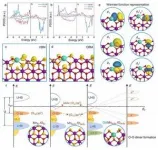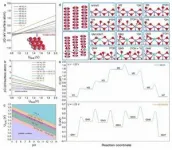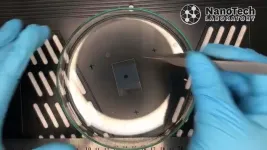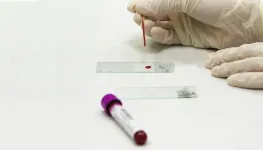(Press-News.org) (Santa Barbara, Calif.) — This week, the National Science Foundation announced the award of a six-year, $22M grant to UC Santa Barbara under its biofoundries program for the establishment of the BioFoundry for Extreme and Exceptional Fungi, Archaea and Bacteria (ExFAB), a collaboration led by UC Santa Barbara (UCSB), together with UC Riverside (UCR), and Cal Poly Pomona (CPP). ExFAB establishes the nation’s first biofoundry that focuses on largely untapped and unexplored extreme microbes. UCSB's award is one of only five grants made under NSF's BioFoundry program during this funding cycle, which awarded a total of $75M to the five selected universities.
“Our campus is thrilled to receive this visionary funding from the National Science Foundation, which reflects the research strength and innovation of our colleagues who are working across disciplines and institutions to advance biotechnology and bioengineering,” said UCSB Chancellor Henry T. Yang. “We congratulate Professor O’Malley and our entire campus team, and thank Michelle for her leadership of this pioneering effort. Our campus is known for our culture of working collaboratively at the cutting edge, and we look forward with great anticipation to the discoveries that will be made through the BioFoundry as our colleagues explore new frontiers in the world of extreme microbes.”
“We are extremely excited because this funding enables us to build infrastructure that nobody, especially in academia, has had access to before,” said ExFAB Director Michelle O’Malley, a professor of chemical engineering and bioengineering at UCSB. “The facility allows us to unlock the promise of a new generation of synthetic biology — one that focuses on developing new biotechnology from extreme and unusual microorganisms found in nature.”
ExFAB will focus on developing techniques to learn from nature’s more unusual microorganisms, referred to as “extreme” in that they do not conform to standard growth habits and culture conditions in a lab. They may have unusual nutritional requirements, grow at extremely high or low temperatures, and even grow without oxygen, all of which makes them difficult to study with existing laboratory equipment.
“These extreme microorganisms defy our current understanding of biology, yet they often host traits that we want to harness for biotechnology – such as enzymes that chew up waste, or pathways that make valuable products and new medicines. Now, with the ExFAB, users have a place to bring their ‘weird’ microbes to study them and prototype new biotechnology from what they learn,” said O’Malley, who is a leading expert in engineering anaerobes to turn waste into more sustainable fuel, chemical, or bio-based materials.
While countless advances have occurred in synthetic biology, which involves engineering nature’s “parts,” such as DNA, proteins, and even entire organisms, to have new functions,
the field has focused on microorganisms that are easy to grow, domesticate, and proliferate under standard laboratory conditions. Yet, domesticated microbes are often devoid of the traits that researchers want to exploit most for biotechnology. The most successful biological products in nature are built almost entirely by unusual microorganisms that have unique growth habits and are unwieldy. To unlock the power of extreme microbes, ExFAB will tap into synthetic biology by designing first-of-its-kind instrumentation, novel robotic workflows, and technology powered by machine learning.
ExFAB will focus its efforts on three research themes — bioremediation, biosynthesis, and rules of life — to design microbes that can address environmental challenges such as the clean-up of PFAS (per- and polyfluoroalkyl substances) and other “forever chemicals,” the sustainable production of silica-based materials, the recycling and reuse of carbon materials, and the promotion of productive carbon and nitrogen cycles in soil and marine habitats.
“UCSB is a world leader in promoting multidisciplinary, center-level science,” said Umesh Mishra, dean of the UCSB College of Engineering. “We are extremely proud to host the ExFAB, because it unites several strengths across our campus for the first time – from marine science to chemical engineering and bioengineering. This sizeable award by NSF raises the profile of our campus and serves as a focal point for continued investment in biotechnology and bioengineering at UCSB.”
“ExFAB provides an exciting opportunity to open synthetic biology to the vast diversity of microbes that nature provides,” added ExFAB co-director Ian Wheeldon, a chemical environmental engineering professor at UCR, who is an expert in synthetic biology and engineering non-conventional microbes. “The current focus of synthetic biology has been to develop new approaches to engineering a small number of commonly used microbes. This facility will dramatically broaden this approach by enabling synthetic biology in any microbe.”
Training a Diverse Workforce
In addition to driving new scientific breakthroughs, ExFAB will establish unique educational programs to train and attract the future biotechnology workforce. ExFAB will recruit California State University (CSU) master’s students to participate in a ten-week research internship at UCSB or UCR, during which they will receive professional development training and work in a scientific community at an R1 (research-intensive) university. ExFAB will also offer a summer school to train and recruit new users.
“Many CSU students want to enter industry or Ph.D. programs but lack the experience in an R1 university setting,” said Jamie Snyder, an associate professor of biological sciences at CPP. “This opportunity will allow them to be trained on automated equipment that they will likely find in industry and to interact with Ph.D. students, postdocs, lab technicians, and senior scientists in R1 labs. ExFAB will enable us to create even more pathways for students, who may not feel represented in the field, to move into the biotechnology workforce.”
All three participating universities are Hispanic Serving Institutions (HSIs) and Asian American Native American Pacific Islander Serving Institutions (AANAPISI).
The Groundwork
UCSB laid the foundation for the ExFAB months before applying to the NSF’s BioFoundries Program when O’Malley, through UCSB’s Institute for Collaborative Biotechnologies (ICB) received a $9.85-million grant through the Department of Defense’s Defense University Research Instrumentation Program (DURIP). The funding allowed the university to purchase a workflow of robotic assembly and analytical tools to enable automated synthetic biology.
“The exciting new investment from the NSF recognizes UCSB’s growing research prominence in the field of synthetic biology and builds upon the recent investment from the Army Research Office,” said chemical engineering professor Brad Chmelka, co-director of ICB. “This NSF award exponentially expands UCSB’s interdisciplinary research culture in biology, materials science, physics, chemistry, and engineering, which will benefit from and can be expected to catalyze new innovations and applications in biotechnology.”
The California Institute of Science and Innovation (CNSI) at UCSB will manage and coordinate ExFAB operations at all three campuses and provide a home for UCSB’s new NSF-funded biofoundry.
“CNSI is proud to be the home of ExFAB and to provide foundational support that will increase the impact of ExFAB innovations,” said CNSI co-director Craig Hawker, a professor of materials and of chemistry and biochemistry. “The unique suite of cutting-edge instrumentation that cannot be found elsewhere will enable translation into technologies that will directly address some of the nation’s biggest challenges, with a workforce that is both ready and able to put these innovations to use.”
External users from industry and academia can access the ExFAB BioFoundry in two ways: direct shipping of samples for complete handling by staff, or on-site training and co-use of equipment with staff. Leadership aims to complete at least 100 total user projects over the first six years, estimating that more than half will be external projects.
“As a Gaucho and the proud Representative for my alma mater in Congress, I am really excited to see the National Science Foundation recognize UCSB's cutting-edge ability to lead on this first-of-its-kind BioFoundry with other California universities,” remarked Congressman Salud Carbajal. “This investment will not only keep UCSB at the forefront of bioscience and bioengineering, but create new good-paying high-tech jobs on the Central Coast and reaffirm that California is the number one place for research in the entire world.”
To learn more, go to exfab.org.
END
UC Santa Barbara to lead $22M NSF-funded center on exceptional microbes
UC Santa Barbara, UC Riverside, and Cal Poly Pomona receive a six-year, $22 million grant to establish a first-of-its-kind BioFoundry.
2024-08-29
ELSE PRESS RELEASES FROM THIS DATE:
Misconceptions about dyslexia among professionals risk children being misdiagnosed
2024-08-29
Misconceptions about dyslexia are held by professionals who assess children for the learning difficulty, according to a new study which calls for evidence-based standardised assessment procedures.
The research, led by Durham University, found that almost half of dyslexia professionals in the study believed at least one unproven indicator for dyslexia, which could lead to children being misdiagnosed.
In a survey of 275 dyslexia professionals, the most common myth – which is not backed up by solid evidence – was that people with dyslexia read letters in reverse order, believed by 61 per cent of specialists.
Just over 30 per cent of professionals also ...
Breakthrough in semiconductor patterning: New block copolymer achieves 7.6 nm line width
2024-08-29
A recently developed block copolymer could help push the limits of integration and miniaturization in semiconductor manufacturing, report scientists in Tokyo Tech and TOK. Chemically tailored for reliable directed self-assembly, the proposed compound can arrange itself into perpendicular lamellar structures whose half-pitch width is less than 10 nanometers, outperforming conventional and widely used block copolymers.
Miniaturization is one of the fundamental qualities of modern electronics and is largely responsible for the incredible increments in performance witnessed ...
Fission chips – How vinegar could revolutionize sensor processing
2024-08-29
Researchers at Macquarie University have developed a new way to produce ultraviolet (UV) light sensors, which could lead to more efficient and flexible wearable devices.
The study, published in the journal Small in July, shows how acetic acid vapour – essentially vinegar fumes – can rapidly improve the performance of zinc oxide nanoparticle-based sensors without using high-temperatures for processing.
Co-author Professor Shujuan Huang, from the School of Engineering at Macquarie University, says: “We found by briefly exposing the sensor to vinegar vapour, adjoining ...
Certain diabetes drugs might prevent dementia
2024-08-29
Sodium-glucose cotransporter-2 (SGLT-2) inhibitors used to treat type 2 diabetes might prevent dementia, providing greater benefits with longer treatment, suggests a large study from Korea published by The BMJ today.
As this study was observational, the researchers note that the effect size could have been overestimated and say randomised controlled trials are now needed to confirm these findings.
According to the World Health Organization, the number of people with dementia globally is expected to reach 78 million ...
Lower HPV vaccination coverage among girls with mental health conditions
2024-08-29
Girls with mental illness or neurodevelopmental conditions are less likely than their peers to be vaccinated with the HPV vaccine that protects against future cervical cancer. This is according to a new registry study from Karolinska Institutet in Sweden published in The Lancet Public Health.
The study involved more than 115,000 girls covered by the Swedish school-based human papillomavirus (HPV) vaccination programme. The vaccine, which prevents cervical cancer, among other things, is offered to all children in Sweden and given by school health services.
Significant ...
Scientists discover how the body's killer cells attack cancer
2024-08-29
Scientists are on the verge of a cancer breakthrough after working out how the body’s immune system targets cells devastated by the disease.
A new study has discovered that our natural killer cells, from the immune system which protect against disease and infections, instinctively recognise and attack a protein that drives cancer growth.
The experts say that by hijacking this protein, known as XPO1, they may be able to activate more killer cells to destroy the disease.
Scientists from the University of Southampton, working with experts worldwide, led the study and now believe it could offer new ...
Interprofessional training in health sciences education has a lasting impact on practice
2024-08-29
Geriatrics experts have long known that collaboration is key to delivering quality, patient-centered care to older adults.
That’s why USC’s Interprofessional Education and Collaboration for Geriatrics (IECG) trains up to 150 students annually from seven health professions to teach the importance of teamwork in meeting the complex needs of the elderly.
Now, a study published in the Journal of Interprofessional Care highlights the long-term impact of IECG on USC health sciences graduates.
Researchers surveyed graduates one to three years after completing IECG to assess how the program influenced their practice. The findings were significant: 81% ...
Study reveals molecular mechanism behind MS and other autoimmune diseases
2024-08-28
New Haven, Conn. — More than two decades ago, a research team in the lab of David Hafler, a Yale researcher who at the time was at Harvard, discovered a type of T cell in humans that suppresses the immune system; they later found that these so-called regulatory T cells, when defective, are an underlying cause of autoimmune disease, specifically multiple sclerosis (MS). For many years, however, the mechanism behind this dysfunction has remained unclear.
In a new Yale-led study, a team of researchers finds that this loss of immune regulation is triggered by an increase in PRDM1-S, a protein involved in immune function, ...
To build a thriving electric vehicle market, prioritize equity and justice
2024-08-28
When it comes to purchasing and using electric vehicles (EVs), housing- and income-related factors significantly shape perceptions and preferences among potential buyers, finds a new study in Energy and Climate Change. This research, a collaboration between the Boston University Institute for Global Sustainability (IGS) and the U.S. Department of Energy’s National Renewable Energy Laboratory (NREL), is among the first to examine both EV adoption and charging infrastructure through an equity lens coupled with state-of-the-art original survey data.
Understanding the barriers to widespread EV adoption ...
Large language models can help detect social media bots — but can also make the problem worse
2024-08-28
An external study of Twitter in 2022 estimated that between a third and two thirds of accounts on the social media site were bots. And many of these automatons flooding social media are dispatched to sow political polarization, hate, misinformation, propaganda and scams. The ability to sift them out of the online crowds is vital for a safer, more humane (or at least more human) internet.
But the recent proliferation of large language models (known as "LLMs" for short), such as OpenAI’s ChatGPT and Meta’s Llama, ...
LAST 30 PRESS RELEASES:
Deep ocean earthquakes drive Southern Ocean’s massive phytoplankton blooms, study finds
Without campus leftovers to pick through, the beaks of this bird changed shape during the pandemic
High-dose antibiotic does not reduce mortality in tuberculous meningitis
How many insects fly in the sky above the USA?
Could cheese protect your brain health?
Who faces more difficulty recovering from stroke?
Colliding galaxies create the brightest, fastest growing black holes at their center
New BrainHealth research reveals tradeoffs on sleep with cannabis use for chronic pain
Aging-US now on ResearchGate, enhancing visibility for authors and readers
'Molecular glue' stabilizes protein that inhibits development of non-small cell lung cancer
Mount Sinai Health System is recognized in 2025 Chime Digital Health Most Wired survey
From prey to predator: How carnivores spread beneficial fungi
Menopause symptoms may be frequent and have negative effects, according to female endurance athletes
US Congressmembers’ responses on X to mass shooting events differ along party lines
KAIST-UEL team develops “origami” airless wheel to explore lunar caves
Individual genetic differences render some therapies ineffective
Engineering dendritic cells boosts cancer immunotherapy
Sophisticated neuroimaging reveals PTSD in WTC responders is linked to measurable physical changes in brain structure
Health policy experts identify promising strategies for providing health care to homeless people
Study explores role of neutrophils in canine atopic dermatitis
Mayo Clinic researchers develop AI-ECG model to diagnose liver disease earlier
Heavy menstruation common among teenage girls – questionnaire reveals risk of iron deficiency
New study explores why open water swimming feels so powerful for midlife women
In echo of Jurassic Park, mosquitoes capture entire ecosystems in their blood meals
Marty Cooper, Illinois Tech Alumnus and ‘Father of the Cell Phone,’ Receives 2025 Marconi Society Lifetime Achievement Award
How to reduce the risk of lymphedema
NEJM Evidence and CIDRAP announce Public Health Alerts
New fossil study illuminates on the evolutionary success of frogs
Patient-specific human liver model to understand disease mechanisms
Confused by the doctor's questionnaire? U of A study suggests it's common
[Press-News.org] UC Santa Barbara to lead $22M NSF-funded center on exceptional microbesUC Santa Barbara, UC Riverside, and Cal Poly Pomona receive a six-year, $22 million grant to establish a first-of-its-kind BioFoundry.




